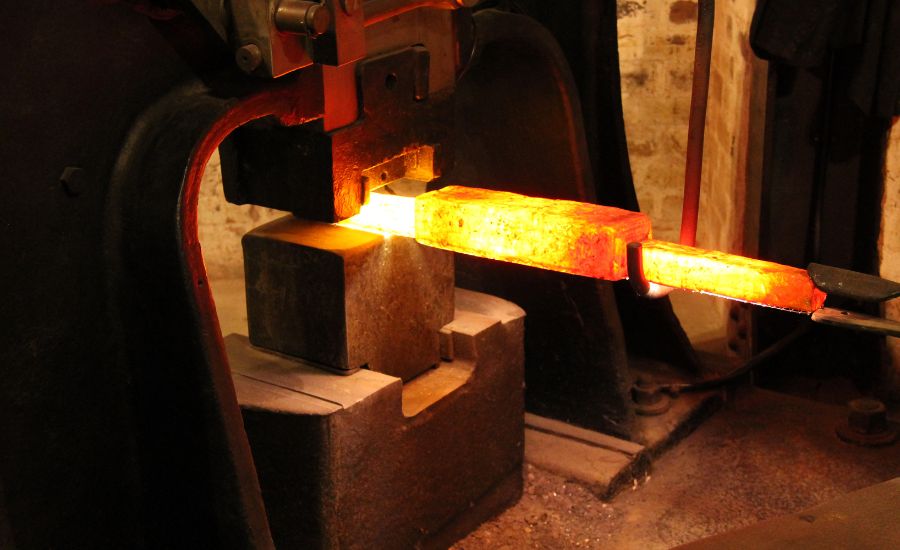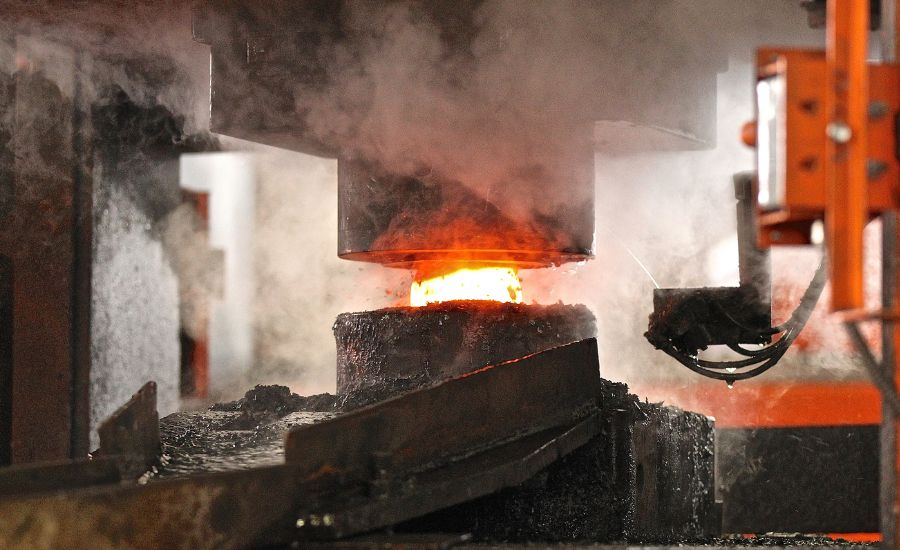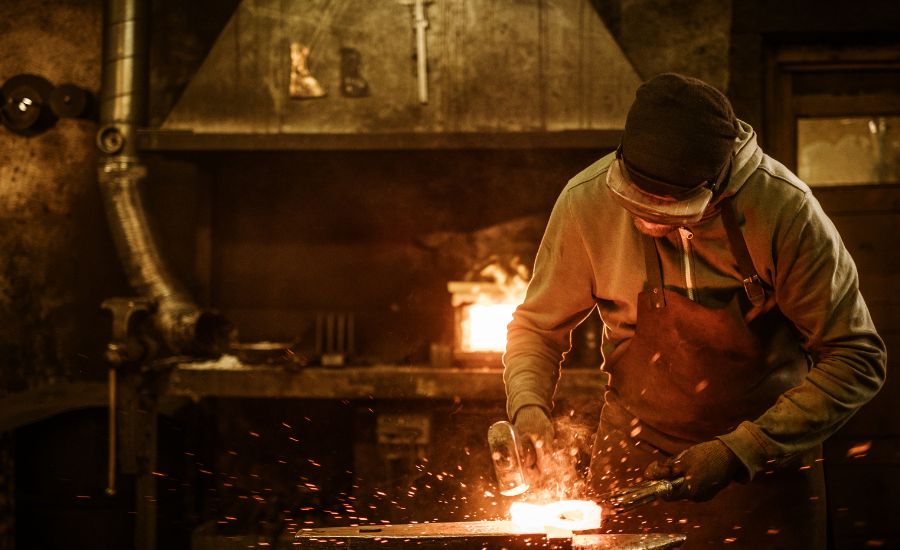In the metalworking technique known as “hot forging,” a metal substance is shaped while being heated to a high temperature. Warming an object to roughly 75% of its melting temperature is known as hot forging. The flow stress and energy needed to form the material are reduced as the temperature of the workpiece before forging near the melting temperature.
Usually, the metal is heated to a temperature slightly below its melting point during the forging process in the forging industry, which makes it more pliable and simple to form. A forge or other type of tooling is often used in the procedure when the hot forged metal is hammered or pressed into the required shape.
A variety of metal items, from microscopic precision bits to massive industrial components, are produced using the popular hot forging process. In comparison to conventional metalworking methods, the forging process has several benefits, including the ability to accurately and precisely manufacture complicated shapes and designs.
Hot forging is a common method for producing parts and components that must withstand severe stress and pressure because it is also known for its strength and durability. In general, we can indentify hot forging process as a flexible and dependable metalworking technique that has been crucial to the manufacturing sector for decades.

Contents
Types of hot forging operation
The manufacturing sector employs a variety of hot die forging methods, including:
Open-hot forging dies. In this forging process, hot forged metal is sandwiched between two flat dies and compressed to shape it. This method is often used to make big, straightforward objects like bars, rings, and cylinders.
Closed die forging process. The forging process with a closed die involves placing hot metal inside and shaping it with compressive pressures. Usually, this method is employed to make more intricate shapes like crankshafts, connecting rods, and gears.

Impression-die forging. In this hot forging process, the hot metal is inserted into a die that has an imprinted pattern or shape. The next step is to use compressive forces to form the metal. Turbine blades and aerospace components are common examples of complex forms that can be produced using this method with high precision and accuracy.
Isothermal forging. During isothermal forging, a consistent temperature is maintained by heating and cooling the metal at a set rate. The isothermal forging method is frequently used to produce items with excellent surface polish and dimensional precision.
Roll forging. In roll forging, the heated metal is formed by being forced under compression as it is moved through a succession of rollers. Usually, this method is employed to make long, cylindrical objects like bars or tubes.
Metal can be formed using either hot or cold forging. The temperature at which the metal is treated is the major distinction between cold and hot forging.
In the hot working process, the hot forge metals are heated above their recrystallization temperature, which is the forging temperature at which the metal’s grains start to reorganize themselves.
This increases the metal’s malleability and facilitates shaping.
This circumstance qualifies hot forging as an important manufacturing process for the production of highly stressed safety components. The metal is then crushed or hammered into the required shape after being placed in a die.

Steel and titanium are two examples of materials that are frequently used in hot forging because they are hard to deform at normal temperatures. On the other hand, cold forming entails working the metal at or near room temperature. After being placed in a die, the metal is compressed repeatedly under high pressure to form it.
Cold-forming forging is frequently employed for intricate geometries that cannot be produced using hot forging, as well as for softer metals like aluminum or copper. Although it typically results in better mechanical properties, frequent forging applications do not benefit from the improvement, and economic advantages continue to be of the most importance.
Forged components can be made from a variety of metals, including steel, steel alloys, aluminum, titanium, and copper. Typically, the metal is heated to a certain forging temperature before being shaped using a qualifying hot die forging or another tool while it is still hot.
Steel, because of its great strength, long lifespan, and ductility, steel is a common material for forging. It is appropriate for a variety of applications since it can be forged into a wide variety of forms and sizes. Aluminum, because of its low melting point, is simple to work with and maybe hot forged into intricate shapes.
Titanium. The aerospace and medical industries frequently employ titanium since it is a sturdy and lightweight material. Corrosion resistance and the ability to hot forge intricate designs make it desirable.
Copper is used frequently in electrical applications, copper is a ductile and soft substance. It has strong electrical conductivity and can be hot forged into complicated shapes. Due to the low melting point and in comparison to many other metals, it is crucial to carefully regulate the temperature throughout the forging process to avoid melting or making the metal too soft.

Alloys with a nickel base, have good mechanical qualities at high temperatures and can be hot forged into intricate shapes. When the metal has been formed, it must cool hot forged parts and harden them to produce sturdy forged components.
In the following situations, hot forging might be the best way to create a metal component:
High strength and durability, the recrystallization process that takes place during heating allows a hot type of forging to create metal components with excellent strength and durability. Complicated shapes, a hot type of forging may produce intricate shapes that would be challenging or impossible to produce using other metal forming techniques.
Massive production runs, and hot types of forging can be used to swiftly and effectively produce a huge number of identical metal components. High precision, metal components can be produced via forging with a high degree of accuracy and precision, allowing for precise tolerances and requirements.
Cost-effectiveness, compared to other processes, forging can result in less material waste and energy use, making it a more affordable way to create metal, therefore hot forging is a more economical choice for creating complex pieces.

Compared to other methods of metalworking, the hot forming forging manufacturing process has some benefits, including:
Superior strength and durability, when compared to other metalworking processes, the hot forming process produces products with a higher degree of strength and durability.
Complex shapes and designs, hot forging manufacturing process can produce complicated shapes and designs with a great degree of precision and accuracy. The malleability of the heated metal makes it easier to shape into complex patterns and shapes.
Reduced material waste, hot forging manufacturing process can utilize less material than conventional metalworking methods, which saves money and reduces waste.
Consistency, the hot forging manufacturing process is a great technique for large manufacturing since it can create items with constant quality and characteristics.
Decreased production time, compared to other metalworking methods, hot forging processes can create parts more quickly, which reduces production time and saves money. Better surface finish, compared to other metalworking methods, hot forging can provide a smoother surface finish, making it perfect for products that need a high-quality finish.
Although hot forging has several benefits, disadvantages of hot forging include the following:
With high energy consumption, the forging method necessitates a significant amount of heating, which can raise production costs. It takes a lot of energy to heat the metal to the requisite temperature for hot forging, which can be costly.
Restricted material options, metals that can be heated and forged, such as steel, aluminum, and copper alloys, are the only types of metals that can be used in hot forging. Due to their characteristics, several other metals might not be appropriate for hot forging.
Equipment costs, the forge, and press, which are necessary for forging, can be costly to buy and maintain. Safety concerns, working with extremely high forging temperature is required while hot forging, which can present several safety dangers to employees if suitable safety measures are not performed.

Restricted design flexibility, hot forging may produce complicated forms and patterns, but the technique might not be the best choice for some designs that call for minute details or sharp edges. When the metal is deformed past its yield point during forging, strain hardening can happen, making the metal harder and more challenging to shape.
Numerous steps can be taken in avoiding strain hardening during hot forging:
Correct heating: It isimportant in avoiding strain hardening: Before forging, the metal needs to be heated to the appropriate temperature. The metal will be harder to work with and more prone to strain hardening if it is too cold. The metal could become overly soft and distort too easily if it is heated up too much.
Proper tooling: To ensure that they apply the necessary amount of pressure and distort the metal, the die, and other hot forging tools must be correctly designed, manufactured, and maintained. Uneven deformation and an elevated risk of strain hardening can result from improper tooling.
Correct cooling: To avoid strain hardening, the metal should be chilled properly after forging. Slow cooling can promote recrystallization and lessen the chance of strain hardening, but rapid cooling can make the metal overly hard.
Correct deformation: To prevent excessive strain hardening, the metal should be deformed in a controlled and consistent manner.
To lessen the amount of deformation necessary, this may entail using numerous forging operations, annealing between steps, or using preheated billets.
In addition, heat treatment is an important part of the hot forging procedure as it can help to improve the mechanical properties of the forged components. Heat treatment involves heating the metal to a specific temperature.

FAQ
What is hot and cold forging process?
Two metalworking techniques, hot forging, and cold forging, are used to form metal materials into desired products. The forging temperature at which the metal is formed is the primary distinction between the two methods.
To make the metal more flexible and simpler to form, hot forging requires heating the metal to a high recrystallization temperature, usually just below its melting point. A forge or other instrument is used to push or hammer the heated metal into the required shape.
The hot forging process is preferred for making items that must withstand high stress and pressure as well as for producing complex shapes and designs with extreme precision and accuracy. In contrast, cold forging involves shaping the metal material without the application of heat at or close to room temperature.
Cold forging shapes the metal using several techniques, including bending, rolling, and pressing. Simple shapes and patterns can be produced using cold forging, which is frequently used for producing parts with a high level of surface quality and dimensional precision.
Overall, hot forging and cold forging are both significant metalworking techniques that are applied in a variety of industries to produce a wide range of metal products. The precise requirements of the product being produced determine which of the two procedures should be used.
What temp is warm forging?
While the precise temperature might vary based on the particular metal being used and the desired result, there is no set temperature range for heated forging. But generally speaking, warm forging entails raising the metal’s temperature to a position between cold forging and hot forging.
Although this temperature range can vary greatly, it typically falls between 400 and 800°C (750 and 1475°F). The type of metal being used, the required qualities of the finished product, and the particular forging method being employed all affect the temperature at which heated forging takes place.
What is the process of forging?
In the metalworking process of forging, compressive pressures are used to mold a metal substance into the required shape. The following steps are often included in the process:
Heating, depending on the type of metal and the intended result, the metal substance is heated to a certain temperature. Forming, after the metal has been heated, it is put into a die or another sort of tooling and compressed. With the use of a hammer, press, or another piece of machinery, these forces can be exerted.
A desired shape is produced when the metal is pressed to adopt the shape of the die or tooling. After being created, the metal is cooled using a variety of techniques, such as air cooling or quenching in water or oil. This enhances the metal’s strength and longevity while also helping to fix its shape.
Finishing, the metal may be finished in a variety of ways, such as polishing, machining, or coating after it has cooled. This enhances the finished product’s appearance and functionality.
What products are made by hot forging?
A variety of metal goods are made using the metalworking technique of hot forgings, such as:
Automobile components, such as engine parts, suspension elements, and steering systems, are frequently made using hot forging. Punches die, and molds are just a few examples of tool and die components that can be produced using hot forging. Hot forging is used to make a variety of aircraft components, including structural parts, turbine blades, and landing gear.
Components for the industrial machine, hot forging can be used to make a variety of parts for industrial machinery, including couplings, shafts, and gears. Medical implants, such as orthopedic implants and dental implants, can be made via hot forging.
A variety of sporting goods, including golf club heads, bicycle parts, and rifle components, can be produced by hot forging.
Conclusion
Hot forging is a flexible metalworking technique that can be used to make a variety of items for different sectors. In comparison to other metalworking methods, the process has several benefits, such as the ability to produce intricate shapes and designs with great precision and accuracy and the end product’s strength and longevity.
Hot forging occurs above the recrystallization temperature of the metal. Varying temperatures have an impact on the metal’s plasticity, and the final quality of the piece, and can affect many of the mechanical properties of the component, such as its strength, ductility, and resistance to impact or fatigue.
Little precision bits to substantial industrial components can be produced using the flexible metalworking technique of forging. The method is frequently used to create parts and components that must bear severe stress and pressure because of their strength and endurance.


